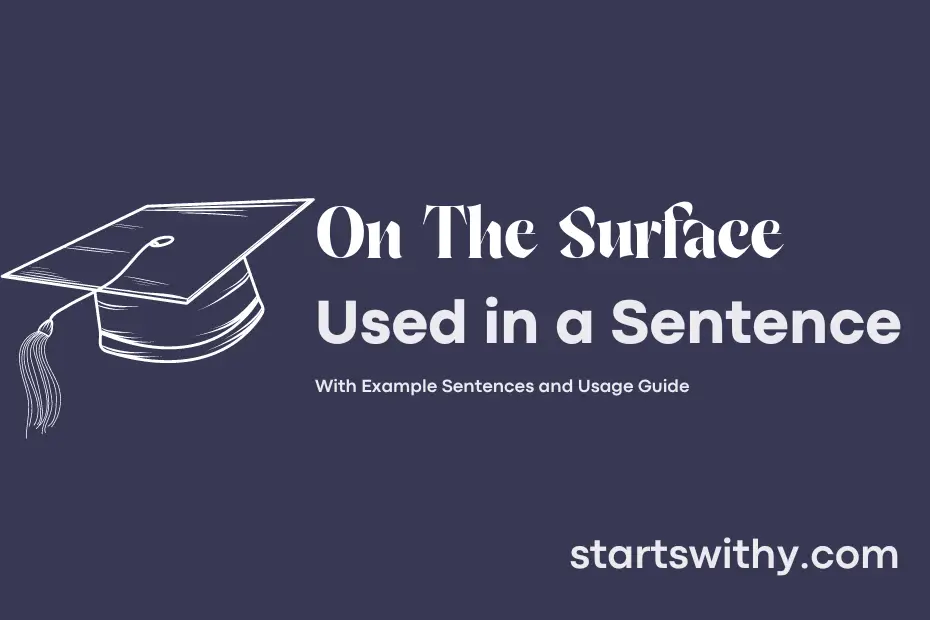Appearances can often be deceiving, showcasing only what is visible on the surface. When something is described as being “on the surface,” it means that it appears a certain way at first glance, but may not reflect the true nature or complexity lying beneath.
This phrase is commonly used to highlight the disparity between outward appearances and deeper truths. It suggests that further investigation or scrutiny may be needed to fully understand a situation, person, or concept.
7 Examples Of On The Surface Used In a Sentence For Kids
- On the surface, the flower looks small and simple.
- The water on the surface of the ocean is clear and blue.
- On the surface, the earth is made up of land and water.
- The clouds on the surface of the sky move slowly.
- On the surface, the apple is red and shiny.
- The sand on the surface of the beach feels warm.
- On the surface, the moon looks like a big circle in the sky.
14 Sentences with On The Surface Examples
- On the surface, attending all your classes may seem unnecessary, but it can greatly improve your understanding of the subject.
- On the surface, joining multiple clubs may seem overwhelming, but it can help you build a strong network and enhance your skills.
- On the surface, pulling an all-nighter may seem like a good idea, but it can negatively impact your health and academic performance.
- On the surface, buying all required textbooks may seem like a waste of money, but they are essential for your academic success.
- On the surface, skipping meals to save time may seem convenient, but it can lead to poor concentration and health issues.
- On the surface, taking on too many courses may seem impressive, but it can result in burnout and lower grades.
- On the surface, relying solely on digital notes may seem efficient, but writing things down can improve retention.
- On the surface, partying every weekend may seem like a good way to relax, but it can affect your focus and overall well-being.
- On the surface, procrastinating until the last minute may seem like a time-saving strategy, but it often leads to rushed and poor-quality work.
- On the surface, socializing constantly may seem like a priority, but finding a balance between social life and academics is crucial.
- On the surface, choosing the easiest elective may seem like a smart move, but taking challenging courses can help you grow academically.
- On the surface, relying solely on lecture notes may seem sufficient, but collaborating with classmates and seeking help can enhance your learning experience.
- On the surface, using online resources exclusively may seem convenient, but discussing concepts with professors can provide valuable insights.
- On the surface, participating in extracurricular activities may seem time-consuming, but they can help you develop essential skills and enhance your resume.
How To Use On The Surface in Sentences?
On The Surface is a phrase used to describe appearances or initial impressions about something that may not reflect its true nature. It is typically followed by a contrasting statement or deeper analysis.
When using On The Surface in a sentence, you can start by describing a superficial observation or commonly held belief about a situation, object, or person. For example, “On the surface, the painting appeared simple and straightforward.”
Following the phrase, you can introduce a contrasting idea or reveal a deeper truth about the subject. For instance, “However, upon closer inspection, the intricate details and hidden layers became apparent, showcasing the artist’s skill.”
Remember that On The Surface is a useful expression for indicating that there may be more to something than meets the eye. It can be effective in analyzing literature, art, behavior, or any other aspect of life where initial impressions might be deceiving.
In summary, using On The Surface can help you highlight discrepancies between appearances and reality. Practice incorporating this phrase into your writing or discussions to add depth and nuance to your observations.
Conclusion
In conclusion, the phrase “on the surface” is often used to describe appearances that may be misleading or superficial. While something may seem a certain way on the surface, further investigation or exploration may reveal a different reality or truth. This term is commonly used to emphasize the need to look beyond initial impressions or indications to gain a more comprehensive understanding of a situation or person.
By recognizing that things may not always be as they appear “on the surface,” individuals can cultivate a more discerning and critical mindset. This can help in avoiding hasty judgments or decisions based solely on superficial observations, encouraging a deeper analysis and consideration of underlying factors. Ultimately, understanding the significance of looking beyond what is presented on the surface can lead to more informed perspectives and interactions in various aspects of life.



